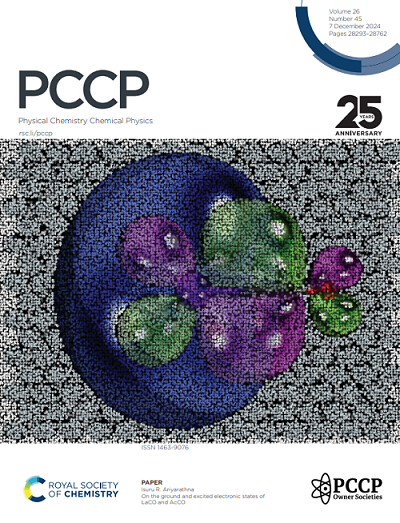Mechanistic elucidation of forming Ta3N5/LaTiO2N heterojunction in improving photocatalytic activity
IF 2.9
3区 化学
Q3 CHEMISTRY, PHYSICAL
引用次数: 0
Abstract
The Ta3N5/LaTiO2N junction is applied in photocatalytic reactions since its favorable band alignment of two components promotes the separation of photogenerated carriers. This conclusion is mainly based on the properties of two isolated, non-interacting materials. However, very little is known from experiment about the real nature of the interface, the stoichiometry and composition of the oxide layers and the atomic arrangements in the heterojunction photocatalyst. In this work, we have investigated the nature of Ta3N5/LaTiO2N by means of density functional theory calculations. The heterojunction models are the Ta3N5(110) surface interfaced with the LaTiO2N(010) surface and the Ta3N5(020) surface matched with the LaTiO2N(002) surface, respectively. Results show that due to strong interfacial covalent bonds, the formation of an Ta3N5/LaTiO2N junction is a favorable process energetically. Ab initio molecular dynamics simulations also prove the stability of studied interfacial structures. The light absorption becomes stronger and is extended after forming the heterojunction structure, which is favorable to enhance the utilization efficiency of solar energy. Ta3N5/LaTiO2N is always expected to behave as a type II heterojunction irrespective of the surfaces of two semiconductors involved in the junction, in which the band edges of Ta3N5 are lower in energy than those of LaTiO2N. This kind of band alignment is favorable for the separation of photogenerated carriers upon photoexcitation, where electrons move toward Ta3N5 and holes toward LaTiO2N. Due to the larger driving force for separating charge carriers, the Ta3N5(110)/LaTiO2N(010) interface is predicted to outperform the Ta3N5(020)/LaTiO2N(002) one. The formation of interfacial structure between Ta3N5 and LaTiO2N induces the more significant separation of photogenerated charge carriers, which may be the origin of enhanced photocatalytic efficiency compared with isolated components.求助全文
约1分钟内获得全文
求助全文
来源期刊

Physical Chemistry Chemical Physics
化学-物理:原子、分子和化学物理
CiteScore
5.50
自引率
9.10%
发文量
2675
审稿时长
2.0 months
期刊介绍:
Physical Chemistry Chemical Physics (PCCP) is an international journal co-owned by 19 physical chemistry and physics societies from around the world. This journal publishes original, cutting-edge research in physical chemistry, chemical physics and biophysical chemistry. To be suitable for publication in PCCP, articles must include significant innovation and/or insight into physical chemistry; this is the most important criterion that reviewers and Editors will judge against when evaluating submissions.
The journal has a broad scope and welcomes contributions spanning experiment, theory, computation and data science. Topical coverage includes spectroscopy, dynamics, kinetics, statistical mechanics, thermodynamics, electrochemistry, catalysis, surface science, quantum mechanics, quantum computing and machine learning. Interdisciplinary research areas such as polymers and soft matter, materials, nanoscience, energy, surfaces/interfaces, and biophysical chemistry are welcomed if they demonstrate significant innovation and/or insight into physical chemistry. Joined experimental/theoretical studies are particularly appreciated when complementary and based on up-to-date approaches.
 求助内容:
求助内容: 应助结果提醒方式:
应助结果提醒方式:


